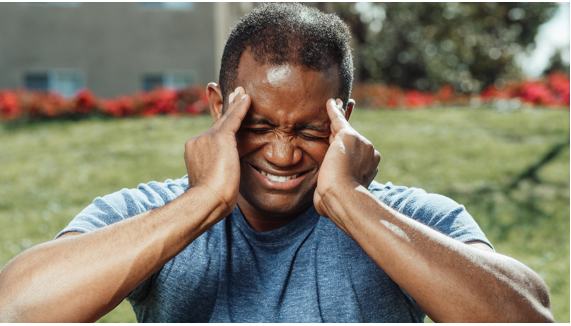Stroke Awareness
HOW TO RECOGNIZE AND PREVENT A DEADLY STROKE
A stroke, sometimes called a brain attack, occurs when blood flow to an area of the brain is blocked or when a blood vessel in the brain bursts. When brain cells are starved of oxygen, they die. It is important to get treatment as soon as possible. A delay in treatment increases the risk of permanent brain damage or death.
The lifetime risk of stroke for women between the ages of 55 and 75 in the United States is 1 in 5. Stroke kills twice as many women as breast cancer, making stroke the third leading cause of death for women.
Most strokes (87%) are ischemic strokes. An ischemic stroke takes place when blood flow through the artery that supplies oxygen-rich blood to the brain becomes blocked. Blood clots often cause the blockages that lead to ischemic strokes.
Signs of Stroke in Men and Women

- Sudden numbness or weakness in the face, arm or leg, especially one side of the body.
- Sudden confusion, trouble speaking, or difficulty understanding speech.
- Sudden trouble seeing in one or both eyes.
- Sudden trouble walking, dizziness, loss of balance, or lack of coordination.
- Sudden severe headache with no known cause.
Most strokes can be prevented by keeping medical conditions under control and making healthy lifestyle changes. Risk factors include the following:

- Smoking damages blood vessels, which can cause a stroke. Approx. 1 in 6 men smokes. Men are also more likely to be smokers than women.
- Overweight and obesity. Being overweight or obese increases stroke risk. About 3 in 4 men in the United States are overweight or obese.
- Diabetes increases stroke risk because it can harm blood vessels in the brain. Approx. 1 in 9 men has diabetes.
- Too much alcohol. Drinking too much alcohol can raise blood pressure levels, and increase the risk for stroke. It also increases levels of triglycerides, a form of fat in your blood that can harden arteries. Men are more likely than women to drink too much alcohol.
Not enough physical activity. Not getting enough physical activity can lead to other health conditions that can raise the risk for stroke.

Know The ABCS of Heart and Brain Health:
- Aspirin: Aspirin may help reduce your risk for stroke. Before taking aspirin, consult with your doctor.
- Blood pressure: Control your blood pressure with healthy lifestyle changes. If a blood pressure medicine is prescribed, take it as directed.
- Cholesterol: Manage your blood cholesterol with healthy lifestyle changes. If a cholesterol medicine is prescribed, take it as directed.
- Smoking: Do not start smoking.
- Eat healthy: Choose healthy foods, including foods with less salt or sodium, to lower your blood pressure, along with foods that are rich in fiber and whole grains to manage your cholesterol.
- Get regular physical activity: Regular physical activity helps you reach and maintain a healthy weight, and keeps your heart and blood vessels healthier. Adults age 18 and older should get at least 150 minutes (or 2 hours and 30 minutes) of physical activity each week and do muscle strengthening activities on two or more days each week.
How To Navigate Life After A Stroke
Even with the best diet, exercise and lifestyle choices, you or someone you know may still experience a stroke in their lifetime. Even though a stroke can happen to anyone, the eldery are especially vulnerable as they age. Although strokes can be life threatening, less severe strokes can leave a person with any number of life altering effects that can have a huge impact on daily life.
Every year, more than 795,000 people in the United States have a stroke, which raises questions about how they’ll navigate everyday living while managing diminished mobility, speech, and cognitive ability. With that in mind, The National Council on Aging (NCOA) has created the, Home Safety for Older Adults: A Comprehensive Guide.
This guide includes a wide variety of practical tips and recommendations from senior safety experts, including:
- Seasonal and material considerations for exterior home safety
- Suggestions for accessibility of everyday items
- Products to help older adults age in place safely
Additionally there is a very helpful actionable PDF checklist that can be useful to ensure you or your loved ones remain safe at home.
Reference: 1.) https://www.cdc.gov/stroke/index.htm 2.) https://www.ncoa.org/
If you liked this post, I’d appreciate if you’d email it to someone who can benefit from its content, or share it on your favorite social media platforms. Also visit https://psy-tek.com/testing/medical-thermal-imaging/ to learn more about this topic. Mention this post to receive 30% off an assessment of your choice.
Bob Hertz co-founded and built PSY-TEK Labs with life partner Dr. Mary Clark. Bob’s 50 plus years of technological, spiritual, and entrepreneurial endeavors, include specializations in leading edge technologies. They comprise scalable Software Solution Developments, Communications, E-commerce, Textiles, Banking and Securities Trading, Pediatric Cardiology, Complementary/Alternative Energy-based Medicine and Energy-based Psychology, as well as Subtle Energy Research.

